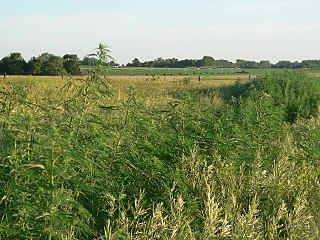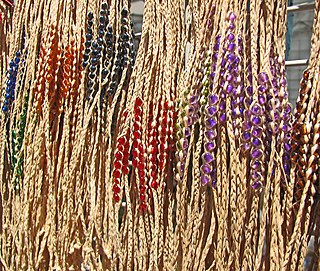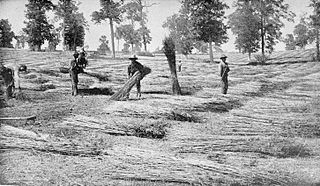
The Marihuana Tax Act of 1937, Pub. L.Tooltip Public Law 75–238, 50 Stat. 551, enacted August 2, 1937, was a United States Act that placed a tax on the sale of cannabis. The H.R. 6385 act was drafted by Harry Anslinger and introduced by Rep. Robert L. Doughton of North Carolina, on April 14, 1937. The Seventy-fifth United States Congress held hearings on April 27, 28, 29th, 30th, and May 4, 1937. Upon the congressional hearings confirmation, the H.R. 6385 act was redrafted as H.R. 6906 and introduced with House Report 792. The Act is referred to, using the modern spelling, as the 1937 Marijuana Tax Act. It was overturned in 1969 in Leary v. United States, and was repealed by Congress the next year.

Jack Herer, sometimes called the "Emperor of Hemp", was an American cannabis rights activist and the author of the 1985 book The Emperor Wears No Clothes. Herer founded and served as the director of the organization Help End Marijuana Prohibition (HEMP).

Hemp, or industrial hemp, is a plant in the botanical class of Cannabis sativa cultivars grown specifically for industrial and consumable use. It can be used to make a wide range of products. Along with bamboo, hemp is among the fastest growing plants on Earth. It was also one of the first plants to be spun into usable fiber 50,000 years ago. It can be refined into a variety of commercial items, including paper, rope, textiles, clothing, biodegradable plastics, paint, insulation, biofuel, food, and animal feed.
Hemp or industrial hemp is a strain of the Cannabis sativa plant grown specifically for the industrial uses of its derived products.

Feral cannabis, or wild marijuana, is wild-growing cannabis generally descended from industrial hemp plants previously cultivated for fiber, with low or negligible amounts of psychoactive tetrahydrocannabinol (THC).

Reefer Madness is a 1936 American exploitation film about drugs, revolving around the melodramatic events that ensue when high school students are lured by pushers to try marijuana – upon trying it, they become addicted, eventually leading them to become involved in various crimes such as a hit and run accident, manslaughter, murder, conspiracy to murder and attempted rape. While all this is happening, they suffer hallucinations, descend into insanity, associate with organized crime and commit suicide. The film was directed by Louis J. Gasnier and featured a cast of mainly little-known actors.

In the United States, increased restrictions and labeling of cannabis as a poison began in many states from 1906 onward, and outright prohibitions began in the 1920s. By the mid-1930s cannabis was regulated as a drug in every state, including 35 states that adopted the Uniform State Narcotic Drug Act. The first national regulation was the Marihuana Tax Act of 1937.
Lyster Hoxie Dewey (1865–1944) was an American botanist from Michigan.

Portland's Hempstalk Festival is an annual event in Portland, Oregon advocating decriminalization of marijuana for medicinal, industrial, and recreational use. Founded in 2005, the festival often takes place the weekend after Labor Day and features food vendors, live music, and information booths. The event has always been free to attend.
The Industrial Hemp Farming Act of 2009, introduced during the 111th United States Congress by House Republican Ron Paul of Texas) and House Democrat Barney Frank of Massachusetts) on April 2, 2009, sought to clarify the differences between marijuana and industrial hemp as well as repeal federal laws that prohibit cultivation of industrial, but only for research facilities of higher education from conducting research. Industrial hemp is the non-psychoactive, low-THC, oil-seed and fibers varieties of, predominantly, the cannabis sativa plant. Hemp is a sustainable resource that can be used to create thousands of different products including fuel, fabrics, paper, household products, and food and has been used for hundreds of centuries by civilizations around the world. If H.R.1866 passes American farmers will be permitted to compete in global hemp markets. On March 10, 2009, both Paul and Frank wrote a letter to their Congressional colleagues urging them to support the legislation. This bill was previously introduced in 2005 under the title of Industrial Hemp Farming Act of 2005.

Hemp jewelry uses hemp twine material which is made from the Cannabis sativa plant, otherwise known as “Common Hemp”, which is cultivated to make goods such as food, fuel, clothing and textiles, cosmetics, paints, paper, building materials, and plastics, among others. Some types of hemp jewelry include bracelets, necklaces, anklets, rings, watches, masks, purses, and other adornments. The jewelry can also make use of other materials, such as glass, wood, bones, rocks, or gems.

Cannabis in Kentucky is illegal for recreational use, and legal for medical use under executive order, with full medical legalization statute taking effect in 2025. Non-psychoactive CBD oil is also legal in the state, and Kentucky has a history of cultivating industrial hemp for fiber since 1775.

Kentucky was the greatest producer of hemp in the United States during the 19th and 20th centuries, when it was the source of three fourths of U.S. hemp fiber. Production started to decline after World War I due to the rise of tobacco as the cash crop in Kentucky and the foreign competition of hemp fibers and finished products. In 1970, federal policies virtually banned the production of industrial hemp during the war on drugs saying all Cannabis sativa is a Schedule I controlled substance. Federal law under the Agricultural Act of 2014 allowed research back into hemp. Kentucky began production again with 33 acres in 2014. As of the 2016 harvest season, only two U.S. states other than Kentucky had over 100 acres (40 ha) in hemp production: Colorado and Tennessee. The first 500-acre commercial crop was planted in Harrison County in 2017, and research permits were issued for over 12,000 acres (4,900 ha) that year. The 2016 documentary Harvesting Liberty concerns the 21st century Kentucky hemp industry.
Cannabis in Italy is currently legal for medical and industrial uses, although it is strictly regulated, while it is decriminalized for recreational uses. In particular, the possession of small amounts of marijuana for personal use is a civil infraction. The possible sanctions for possession vary from the issuing of a diffida to first offenders, that is an injunction not to use the drug again; to the temporary suspension of certain personal documents for repeat offenders. Conversely, the unauthorized sale of cannabis-related products is illegal and punishable with imprisonment, as is the unlicensed cultivation of cannabis, although recent court cases have effectively established the legality of cultivating small amounts of cannabis for exclusively personal use. The licensed cultivation of cannabis for medical and industrial purposes requires the use of certified seeds; however, there is no need for authorization to plant certified seeds with minimal levels of psychoactive compounds.

Cannabis has been cultivated in Japan since the Jōmon period of Japanese prehistory approximately six to ten thousand years ago. As one of the earliest cultivated plants in Japan, cannabis hemp was an important source of plant fiber used to produce clothing, cordage, and items for Shinto rituals, among numerous other uses. Hemp remained ubiquitous for its fabric and as a foodstuff for much of Japanese history, before cotton emerged as the country's primary fiber crop amid industrialization during the Meiji period. Following the conclusion of the Second World War and subsequent occupation of Japan, a prohibition on cannabis possession and production was enacted with the passing of the Cannabis Control Law.

Cannabis is illegal in Russia. Possession of up to 6 grams is an administrative offense, punishable by a fine or detention of 15 days. Possession of larger amounts is a criminal offense.

Terms related to cannabis include:

The history of cannabis and its usage by humans dates back to at least the third millennium BC in written history, and possibly as far back as the Pre-Pottery Neolithic B based on archaeological evidence. For millennia, the plant has been valued for its use for fiber and rope, as food and medicine, and for its psychoactive properties for religious and recreational use.
Hemp paper is paper varieties consisting exclusively or to a large extent from pulp obtained from fibers of industrial hemp. The products are mainly specialty papers such as cigarette paper, banknotes and technical filter papers. Compared to wood pulp, hemp pulp offers a four to five times longer fibre, a significantly lower lignin fraction as well as a higher tear resistance and tensile strength. Because the paper industry's processes have been optimized for wood as the feedstock, production costs currently are much higher than for paper from wood.

Hemp in the United States was a legal crop in the 18th and 19th centuries. Production was effectively banned in the mid-20th century, but it returned as a legal crop in the 21st century. By 2019, the United States had become the world's third largest producer of hemp, behind China and Canada.















